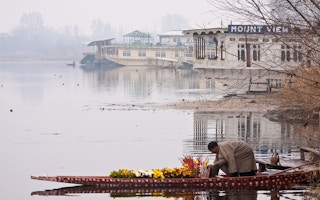The world’s tallest railway bridge, in the underdeveloped, mountainous region of Jammu and Kashmir, promises to provide a vital transportation link with the rest of India when it becomes operational.
The Chenab Bridge was built to span a gap across the Chenab River of more than 470 metres and boost the economy of one of India’s poorest regions by improving connections year-round.
At 359 metres tall, the engineering wonder stands higher than the Eiffel Tower in Paris and the Statue of Liberty in New York City. Its design uses an engineering concept called “blast load” to withstand the impact of explosion such as from terrorist attacks and the resulting shock waves and debris.
Shair Khan, a 45-year-old from the Reasi district of Jammu and Kashmir, in the Himalayas, believes it will be a lifeline, especially during the challenging winter months.
“In winter, heavy snow and landslides cut us off from the world,” he told SciDev.Net.
“Now, with this bridge, we hope to stay connected all year round. It gives us hope for 12 months of connection and the chance for more businesses to come to our district.”
The first-ever multidimensional poor index report released in 2021 by India’s policy think-tank NITI Aayog, registered poverty in Jammu and Kashmir at almost 13 per cent. The poorest district, Bihar, had a poverty index of 52 per cent.
When fully operational, the Chenab Bridge should enable people and goods to flow to and from the region, boosting the local economy, especially the saffron trade and tourism.
The central government of India is expected to announce the opening of the bridge before the May 2024 national elections.
“
Its resilience to seismic activity, withstanding up to an 8.0-magnitude earthquake, underscores the meticulous engineering and proactive measures employed in its design, ensuring safety and stability for generations to come.
Irfan Hashim, researcher, University of Kashmir
Winter isolation
Connecting the region is a challenge due to its imposing mountains. Previously, the only land route connecting Kashmir with the rest of the country was the winding 300-kilometre (185-mile) Srinagar-Jammu national highway, which closes during part of the winter and is frequently disrupted by landslides.
The treacherous road is also prone to accidents and has claimed many lives. In the past year, there were 648 accidents on this road, causing 93 deaths according to India’s Ministry of Road Transport and Highways.
Deputy chief engineer of Konkan Railway, Rashmi Ranjan Mallick, said building in such challenging terrain was difficult, considering the tough geography. Adverse weather conditions further complicate material transport and construction efforts.
More than 1,300 workers and 300 engineers have been working on building the bridge. Construction began in 2004 but paused in 2008 to 2009 due to concerns about passenger safety in strong winds.
Railway authorities considered other locations due to high-speed winds of 100 kilometres per hour. However, the original site was eventually deemed the most suitable.
The bridge is part of the Udhampur-Srinagar-Baramulla rail link project, with an overall cost of 37,000 crore rupees (US$4.46 billion). It will be crossed by Vande Bharat Express trains, designed to work well in the region’s extreme temperatures and high altitudes.
Irfan Hashim, a researcher at the University of Kashmir’s Media Education Research Centre, said the bridge will be a vital link between people and markets, improving travel safety and efficiency.
“Its resilience to seismic activity, withstanding up to an 8.0-magnitude earthquake, underscores the meticulous engineering and proactive measures employed in its design, ensuring safety and stability for generations to come,” he told SciDev.Net.
During harsh winters, Kashmir faces substantial losses due to severe weather and road blockades from landslides, says Tariq Ghani, president of the Chamber of Commerce and Industry Kashmir.
He believes the Chenab Bridge will boost economic growth by improving connectivity and trade throughout the year, opening up opportunities for business, tourism and overall development.
However, others have expressed concerns about the bridge.
“We are concerned about potential disturbances caused by train noise and vibrations affecting daily life,” Reasi district resident Abdul Khaliq told SciDev.Net.
He also stressed the importance of maintaining peace in local communities and preserving the environment.
Irfan Khan, a taxi driver from the Tourist Taxi Stand in Srinagar, said he and many other taxi and truck drivers were worried about the potential impact of the bridge on their livelihoods.
“The completion of the bridge has brought uncertainty about the future of our jobs, with potential changes in transportation routes affecting their earnings,” he said.
This article was originally published on SciDev.Net. Read the original article.








